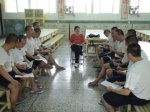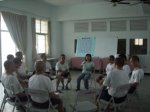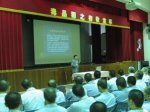Education and instruction
Foreword
Between the time of Japanese rule to today, the methods of education and instruction have not changed much; the only difference is the environment. The human rights of convicts has increasingly garnered more attention, the Department of Education and Instruction has a teaching location in Lutsao by the National Open University, so that convicts from across the nation can have the opportunity to enter colleges, to arrange for progressive correction and education; this has enhanced the educational quality for inmates. The Department of Education and Instruction is concerned with how to help inmates reform themselves and to face themselves again.
Method of instruction

(Prisoners instructed together)
(picture source:The Chiayi Prison Web)
- Group instruction:
Themes are determined for groups of different ages, and some special methods are used to teach the inmates. For example, using psychological skits to make them trade roles with each other, so they can try to empathize and deeply understand.
- Categorized instruction:
Education is different for some convicts with heavier sentences.
- Individual instruction:
Individual discussions with inmates so they can dispel stress accumulated over long periods of time, and they are also offered suggestions and teachings.

(Prisoners instructed individually)
(picture source:The Chiayi Prison Web)
- Opportunity instruction:
When events occur, instruction is provided specific those events, to teach inmates how to resolve problems. When inmates are involved in riots or conflicts over interest, the instructor must instruct them at that time.
- Religious instruction:
This is an instructional method that has existed since Japanese rule. Usually, two to three sessions per week are reserved for religious instruction. The order of appearance is Buddhism, Christianity, and Catholicism; instruction is conducted by Buddhists from temples, Christian pastors, and Catholic priests.

(Prisoners instructed drug offenders)
(picture source:The Chiayi Prison Web) Other than instruction by religious personnel, some high school or junior high school clubs are also in frequent contact with the prison. They come to perform at the prison, so convicts feel less disconnected from society. The effect of religion is influential on the inmates; it can calm their anxious hearts and give them a sense of belonging.
- Other than teaching, there is also progressive correction:
This is divided into four levels. The convicts who have just arrived first live in rooms for the new convicts, then move into the level four rooms after they have work assignments. With good behavior and the accumulation of points, a certain amount of points would allow the prisoner to move up to a level 3 room, and so on.
- Parole:
According to Clause 77 of the Criminal Law, a prisoner must serve half of his sentence before being eligible to apply for parole to the Ministry of Justice. In addition, they must be at least above a level 2 in accumulated rank, and have at least three points for education and instruction, operations, and behavior in three months prior to the application. The new prison association elects professionals as parole commissioners who can provide fair parole suggestions.
Sources:
-
Researched and organized by this team
-
Interviews with Ms. Chiu
-
Education and instruction
